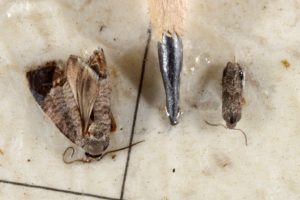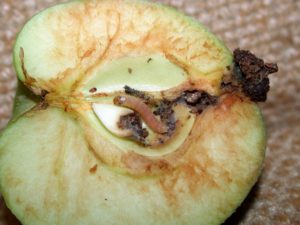The horticultural entomology team is happy to report that we’re continuing efforts to support Indiana apple growers by monitoring tree fruit pests and reporting what we find!

Figure 1. Oriental fruit moth monitoring trap in ‘Gold Rush’ block at Meigs Purdue Agricultural Center (Lafayette, IN). Photo: E. Y. Long
On April 22, 2020, we placed pheromone-baited monitoring traps for two important tree fruit pests, the codling moth and Oriental fruit moth at the Meigs Purdue Agricultural Center in Lafayette, IN (Figure 1). This is the tree fruit research orchard nearest to Purdue’s West Lafayette campus, with roughly 20 acres of tree fruit: mostly apples, but also pears, peaches, and plums.
Now, a bit about the pests and why we monitor them: the codling moth (CM) and Oriental fruit moth (OFM) are known as Tortricid or ‘leafroller’ moths, a group that includes more than 10,000 described species! Although monitoring efforts in the orchard are focused on the adult moths, the damaging life stage of these insects is the caterpillar. Both CM and OFM caterpillars burrow into fruits to feed (Figure 2), often leaving behind a trail of solid insect waste, known as frass. This feeding damage can destroy fruits entirely or lead to misshapen fruits that drop prematurely. Additionally, caterpillar feeding wounds on fruits can make them more vulnerable to fruit diseases.
Pheromone monitoring traps work by attracting male moths to a lure that mimics the smell of a female moth. As males fly through the orchard searching for a mate, they are attracted to the lure, thinking it is a female! When they arrive at the trap, they land in a sticky substance that prevents them from leaving. This makes it much easier to detect adult moth activity: anyone who checks the trap will see if adult moths are present, and once you see them you know it’s time to take action to protect the trees and fruit. There are several generations of CM and OFM each year, so use of pheromone monitoring traps can dramatically improve detection and thus protection of your tree fruit crop! To further enhance knowledge of CM and OFM activity and their progress through the life cycle, you can track degree days to predict how quickly these insects are developing based on daily high and low temperatures. Because insect development is temperature dependent, progress from one life stage to the next (for example, the egg stage to the caterpillar stage) may speed up or slow down depending on daily temperatures. Tracking degree days may be especially useful this season, given the cool-wet weather and fluctuating spring temperatures.

Figure 3. Adult codling moth (left) and Oriental fruit moth (right) trapped on bottom of sticky monitoring trap. Photo: John Obermeyer, Purdue University
The ultimate goal of pheromone trap monitoring and tracking degree days is to keep track of peak adult flight activity and egg hatch, so that you can properly time insecticide applications to target newly-hatched caterpillars, which are most susceptible to insecticides. Pheromone traps for these moths are relatively inexpensive ($10.50 each at Great Lakes IPM online store) and are just as useful for backyard orchards with only a few trees.
As of May 4, 2020, we have not detected any codling moths or Oriental fruit moths in our monitoring traps. But when we do, you can count on us to let you know via our Purdue Fruit & Veg IPM Facebook page, Purdue Extension Entomology Twitter feed, and the Purdue Extension Entomology Fruit IPM website (once it’s updated and live)! In the meantime, please remember that as long as fruit trees are blooming, they are attractive to pollinators! So please help protect them and do not spray insecticides or miticides during bloom.
Here’s to a happy fruiting season! Feel free to reach out with any questions you might have!
